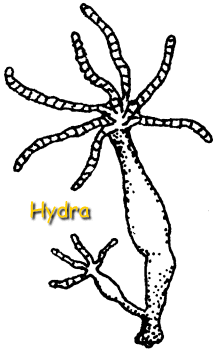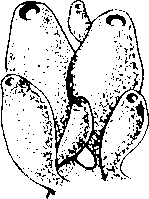Name _____________________________________
Chapter 29 Study Guide
1. Name 3 examples of cnidarians.
2. How does a hydra move? _____________________
3. Identify this organism. ___________________
4. What type of symmetry does it have? _________________
5. Are sponges autotrophs or heterotrophs? _______________
6. Digestion in the hydra takes place in this cavity. ____________________
7. The scientific name for a blood fluke is ___________________
8. A planarian has an anus (true or false) ___________________
9. Stinging cells in cnidarians are called ___________________
10. Which worm had a pharynx? ______________________
11. To what Kingdom do sponges belong? ________________
12. What organism did we study that was a filter feeder? ______________
13. What is the intermediate host of schistosoma? ____________
14. What type of symmetry does the planarian have? _________________
15. The simplest multicellular animal is the _______________
16. Which cnidarian (jellyfish, coral or hydra) spends the majority of its life as a medusa? ______________________
17. The “harpoons” on the cnidarian stinging cells are called ________________
18. Muscle soreness is a symptom of what parasitic infection? _________________
19. Hydras attach themselves to rocks with their _____________________
20. Which organism (hydra, planarian, or sponge) is sessile? _________________
21. Which organism (planarian, roundworm, hydra) has a complete digestive tract? ___
22. Each segment of a tapeworm is called a ________________
23. Cells in the sponge that digest food are called _________________
24. Which organism (sponge, planarian,or tapeworm) lives in a host? _____________
25. Which organism (sponge, planarian, or tapeworm) has an eyespot? ____________
|
26. A planarian can reproduce by regeneration (true or false) _____________ 27. Identify this organism. (hydra, jellyfish, sponge, or sea anemone) _____________________ 28. What type of symmetry does it have? _________________ 29. Where do hydras live? _______________ 30. A person would get trichinosis (trichinella) from eating ____________ |
 |
Choose the pairs that are most closely related. (circle)
31. Portuguese man of war & jellyfish OR sea anemone and sponge
32. Planarian & roundworm OR planarian & tapeworm
33. Jellyfish & tapeworm OR tapeworm & fluke
34. Sea anemone & hydra OR roundworm & sponge
35. Sponge & hydra OR hydra and jellyfish